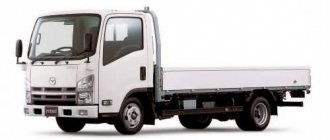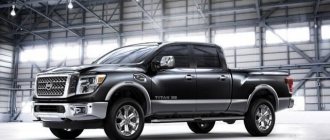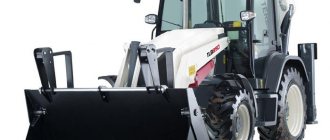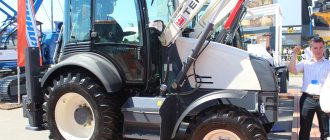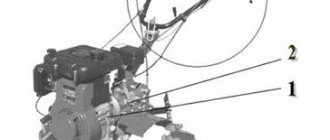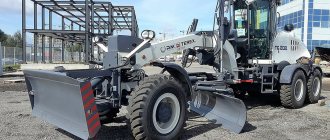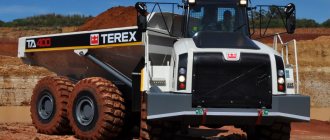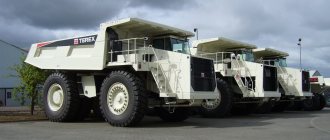Mazda Titan trucks have proven themselves well not only in their homeland in Japan. These reliable and unpretentious trucks are widespread in various modifications, so they are often found on European and Russian roads.
Modifications
The lightest modifications of Mazda Titan cars can transport loads weighing up to 1.5 tons, and the most powerful options have a load capacity of up to 4 tons. Among the body options, the leaders are:
- flatbed cars
Flatbed truck with single cab
Flatbed Mazda Titan Double Cab
- vans and refrigerators
Reefer van
- often found Mazda Titan dump truck
Dump truck
- as well as onboard vehicles with a crane-manipulator
Mazda Titan truck with installed CMU
Mazda Titan: overview of all generations
The first generation of Mazda Titan trucks was released in 1971 to replace the E2000 model. From its predecessor, the new cars inherited only the 2.5-liter XA diesel engine, which was installed on the most budget modifications. Models with higher payloads were equipped with a 2.7-liter XB diesel engine producing 81 hp, and for the heaviest versions a 100-horsepower 3.7-liter XC engine was offered. In addition to models with a diesel engine, there were also versions with a 2.0 liter four-cylinder petrol engine.
First generation
After the facelift carried out in 1977, the Mazda Titan truck was transformed thanks to a new radiator grille, and the shape of the bumpers and cabin vents also changed. Mazda Titan's turn signals have been enlarged, and the company's corporate logo has been modified. The truck was produced in this form for another three years.
In 1980, Mazda introduced the second generation Titan. In addition to the existing line of power units, the trucks received new six-cylinder ZB diesel engines with a volume of up to 4052 cc. Cars produced after 1987 can be distinguished by head optics with four square headlights instead of the previously installed round ones.
Second generation, pre-restyling model with twin round headlights
The third generation Mazda Titan trucks, released in 1989, received a completely new body. Thanks to the enlarged special recesses that have appeared in the side windows of the new Mazda Titan, visibility from the driver's seat has improved significantly. This design became a distinctive feature of all subsequent versions of the truck. For the first time, modifications with a seven-seat double cabin appeared, known in Russia as the Mazda Titan two-cabin. In addition, the updated Mazda Titan trucks were produced in three versions, differing in wheelbase length: Standard, Long and Super Long and two loading heights.
Mazda Titan third generation
To comply with stricter emission standards in 1994, trucks began to be equipped with 4HF1 and 4HG1 engines manufactured by Isuzu. In 1997, the car was once again modernized. This time the shape of the windshield and grille has changed, and the double square headlights have been replaced by single ones.
More on the topic: ZIL Bychok is an ideal car for transporting furniture around the city
The next, fourth generation of the truck was produced from 2000 to 2010. At this time, the cabin interior was updated, all Mazda Titan trim levels received airbags for the driver, and the ergonomics of the driver's seat were improved. The video clearly shows that in terms of comfort and convenience, the interior of the truck is close to that of passenger cars.
Since 2004, OEM versions of Isuzu Elf trucks have been produced under the Mazda Titan brand.
The fourth generation Mazda Titan looks modern even today
The fifth generation of the truck did not last long - from 2004 to 2007. Just like the previous generation, Mazda Titan trucks released at this time were a copy of the Isuzu Elf with a Mazda nameplate on the hood.
On fifth-generation trucks, spectacular chrome elements are replaced by more practical plastic ones
The sixth generation Mazda Titan, produced from 2007 to the present, is no exception, completely similar to the sixth generation Isuzu Elf.
The sixth generation Mazda Titan looks the most presentable
Since trucks like the ones described above are used as “workhorses”, and the design of the cars does not require major modifications, tuning the Mazda Titan is rare and comes down to installing additional aerodynamic fairings.
Aerodynamic fairing and chrome air signal are the main elements of truck tuning
Development and production
General Motors developed the Titan in response to the need for more efficient haul trucks. quarry operators. GM believed that the overall decline in mineral ore quality, coupled with the anticipated demand for tar shale and oil sands production, would increase the amount of ore trucked by quarry operators around the world.[1] The Titan was the largest in the Terex 33 series of off-road tractors, which also included the 33-03, 33-05, 33-07, 33-09, 33-11 and 33-15. The 33-19 and 33-15 models used AC diesel/electric powertrains, while other, smaller 33 Series dump truck models used manual transmissions.
The Titan was assembled at the General Motors Diesel Division assembly plant in London, Ontario, Canada in 1973.[2][3] Titan was first shown to the public in October 1974 at the American Mining Congress in Las Vegas, Nevada.[4]
GM predicted that when the Titan entered regular production, it would cost approximately US$1.5 million in 1976 (or $7 million today).[5][6] However, the Titan never entered mass production. The global coal market softened in the late 1970s, resulting in reduced production from coal mines and savings from refurbishing existing equipment or purchasing smaller trucks with proven performance records. The intended market for the 33-19 Titan never materialized, and the prototype was the only unit ever assembled.[2]
Technical characteristics of Mazda Titan
- Overall dimensions (length/width/height): 4460 mm/1695 mm/1930 mm
- Maximum speed: 120 km/h
- Fuel tank capacity: 70 l
- Transmission: manual 5-speed
- Steering: rack and pinion with hydraulic booster
- Brake system: drum brakes front and rear
- Suspension: semi-elliptical multi-leaf springs
- Tire size: 6.50 – 16 LT
Mazda Titan: engine specifications
- Engine type: diesel, in-line, 8-valve
- Number of cylinders: 4
- Power system: pressurized fuel injection
- Gas distribution system: OHV
- Engine capacity: 3059 cc, 3459 cc, 4570 cc
- Engine power: 95 hp, 109 hp, 121 hp
- Maximum torque: 169 Nm, 284 Nm, 322 Nm
Public display
Restored Titan 33-19 front view on static display in Sparwood, British Columbia in Terex green livery.
Following its acquisition of the Sparwood Mine in late 1992, the Tek Corporation offered the Titan for preservation as a public monument in 1993. The Sparwood BC Chamber of Commerce has completed fundraising, restored the Titan and is promoting it as a tourist attraction. Titan on static display off Highway 3 at Titan Park, 126B Aspen Drive, Sparwood, British Columbia, Canada.[10] Although the 33-19 Titan was restored, the engine was removed.
Titan starred in a 1977 Terex television commercial. [11] Along with golf, Jack Nicklaus is excellent. The commercial begins with Nicklaus standing on a loaded Titan platform, hitting golf balls, and ends with a panorama of Nicklaus standing among several modern Terex products.
Recommendations
- "350-ton dump trucks hit the industry." Age
. Melbourne, Victoria, Australia: Fairfax Media. 1975-05-19. Earth motion function. Retrieved 2010-03-15. ...Titan was designed and built to meet the mining industry's current and future needs for more efficient, high-performance trucks... - Alves, Michael; Haddock, Keith; Halberstadt, Hans; Sargent, Sam (December 27, 2003). "Chapter 5: SUVs." Heavy Equipment
(Crestline ed.). St. Paul, MN, USA: MBI Publishing Company. ISBN 978-0-7603-1775-4. Retrieved 2011-04-08. With a payload of 350 tons, it was the largest truck in the world, a title it held for about 25 years. - “CPI Inflation Calculator.” bls.gov
. US Bureau of Labor Statistics. 2011. Retrieved 2011-04-08. $1,500,000 in 1976 has the same purchasing power as $5,834,156.41 in 2011. - "Sparwood District - Titan Terex." sparwood.bc.ca
. Sparwood area. Archived from the original on 2010-03-02. Retrieved 2010-03-01. Visit Terex Titan located in Sparwood... - Haddock, Keith (1998-08-16). "Chapter Six SUVs." Giant Earth Movers An Illustrated History
. Crestline. United States of America: MBI Publishing Company. ISBN 978-0-7603-0369-6. Retrieved 2010-03-01. The Titan... (was) built by GM's diesel division in London, Ontario. - Hoppe, Richard, ed. (1978-07-01). E/MJ Operation Handbook of Mineral Surface Mining and Exploration
. E/MJ Library of Operating Handbook. Vol. 2 (hardcover ed.). New York, NY, USA: McGraw-Hill Higher Education. ISBN 978-0-07-019518-9. Retrieved 2011-04-08. The 33-19 prototype has been in operation at the Kaiser Steel Eagle Mountain iron mine in California since January 1975. - Lamm, Mike (October 1976). "The biggest truck in the world." Popular Mechanics
.
New York, New York, USA: Hearst Corporation. 146
(4). OCLC 61313194. Retrieved 2011-04-08. GM operates a Titan truck at the Kaiser iron mine in Eagle Mountain, California. - Mercer, Mike (1999-03-01). "A New Era of Mining Truck Giants." Diesel Progress North American Edition
. Diesel Progress. Archived from the original on 2010-03-02. Retrieved 2010-03-01. Back in 1973, Terex developed a three-axle dump truck with a capacity of 350 tons... - "Terex 33-19 Hauler Form No. GMD 1946" (PDF). Canada: Terex Division of General Motors Corporation. December 1974. Retrieved 2010-08-30.
- Woof, Mike (24-03-2006). Hitch, Lindsey; Hansen, Steve (ed.). Ultra Haulers: The World's Mining Giants
. United States of America: MBI. ISBN 978-0-7603-2381-6. Retrieved 2010-03-01. ... 33-19, which offered a 350 US ton/316 ton capacity that would not be surpassed for over 20 years. - Wilson, Donald Malcolm (2002). "Sparwood, BC" Crowsnest Highway
. Archived from the original on 06/25/2017. Retrieved 2017-08-22. For $55 per share in September 1980, the government-owned BC Resource Investment Corporation (BCRIC) bought Kaiser Resources, lock, stock and barrel.
Notes
- Age 1975, paragraph 19.
- ^ a b
Haddock 1998, p. 121. - Mercer 1999.
- Haddock 1998, para. 122.
- ^ a b
Lamm 1976, p. 162. - US Bureau of Labor Statistics, 2011.
- Hoppe 1978, para. 217.
- Lamm 1976, para. 89.
- Wilson 2002.
- Sparwood District 2010.
- https://www.youtube.com/watch?v=9fowP7RQmMY
- ^ a b
Terex Division 1974, paragraph 2. - Alves et al. 2003, paragraph 51.
- Woof 2006, paragraph 26.
- Lamm 1976, para. 158.
- Terex Division 1974, paragraph 1.
